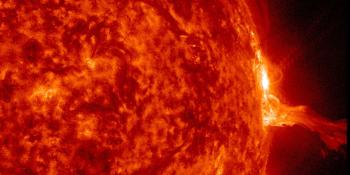Viewing archive of Tuesday, 6 May 2025
Daily bulletin on solar and geomagnetic activity from the SIDC
Issued: 2025 May 06 1231 UTC
SIDC Forecast
Solar flares
C-class flares expected, (probability >=50%)
Geomagnetism
Active conditions expected (A>=20 or K=4)
Solar protons
Quiet
| 10cm flux | Ap | |
|---|---|---|
| 06 May 2025 | 159 | 016 |
| 07 May 2025 | 159 | 015 |
| 08 May 2025 | 157 | 010 |
Solar Active Regions and flaring
Solar flaring activity was low over the past 24 hours, with only C-class flares identified. SIDC Sunspot Group 492 (NOAA Active Region [AR] 4082, Beta-Gamma magnetic configuration) produced three C-class flares, including the brightest event, a C2 on 5 May at 18:39 UTC. SIDC Sunspot Group 469 (NOAA AR 4079) remains very calm considering its size and Beta-Gamma-Delta magnetic configuration, as it only produced three C1 flares during the past 24 hours. For the next 24 hours C-class flares are expected, although isolated M-class flaring remains possible.
Coronal mass ejections
No Earth-directed Coronal Mass Ejections (CME) were observed in the last 24 hours. A CME seen in LASCO-C2 images as launched on 5 May at 15:00 UTC is a back-sided event and not expected to reach Earth.
Solar wind
During the last 24 hours the Solar Wind (SW) conditions remained affected by the High Speed Stream (HSS) that arrived on 4 May. However, the effect is now waning as evident from the drop of the SW speed from 800 km/s to 600 km/s during the last 24 hours. The interplanetary magnetic field (B) varied between 3 and 7 nT and its North-South component (Bz) fluctuated between -6 and 5 nT during the same period. The SW conditions are expected to remain affected by the HSS during the next 24 hours, although the decline is very likely to continue.
Geomagnetism
Geomagnetic conditions registered globally minor storm levels for a short period of time (NOAA Kp 5- on 5 May from 15:00 to 18:00 UTC), while of the rest of the last 24 hours they fluctuated between quiet and active levels (NOAA Kp 2+ to 4). Locally the geomagnetic conditions registered only up to active levels (K BEL 2 to 4) during the same period. In the next 24 hours they are expected to continue at active levels both globally and locally.
Proton flux levels
The greater than 10 MeV proton flux, as measured by the GOES-19 satellite, was at nominal levels over the past 24 hours and is likely to remain so in the next 24 hours.
Electron fluxes at geostationary orbit
The greater-than-2 MeV electron flux as measured by GOES 19 was above the 1000 pfu threshold level for most of the past 24 hours, with a peak value at 16000 pfu. It is expected to remain in the same pattern during the next 24 hours but marginally subside. The 24-hour electron fluence increase to high levels since 6 May 04:50 UTC and is expected to continue at high levels for most of the next 24 hours.
Today's estimated international sunspot number (ISN): 097, based on 14 stations.Solar indices for 05 May 2025
| Wolf number Catania | 163 |
| 10cm solar flux | 159 |
| AK Chambon La Forêt | 031 |
| AK Wingst | 026 |
| Estimated Ap | 028 |
| Estimated international sunspot number | 102 - Based on 21 stations |
Noticeable events summary
| Day | Begin | Max | End | Loc | Strength | OP | 10cm | Catania/NOAA | Radio burst types | |
|---|---|---|---|---|---|---|---|---|---|---|
| None | ||||||||||
Provided by the Solar Influences Data analysis Center© - SIDC - Processed by SpaceWeatherLive
All times in UTC
Latest news
Latest forum messages
Support SpaceWeatherLive.com!
A lot of people come to SpaceWeatherLive to follow the Sun's activity or if there is aurora to be seen, but with more traffic comes higher server costs. Consider a donation if you enjoy SpaceWeatherLive so we can keep the website online!

Space weather facts
| Last X-flare | 2025/05/13 | X1.1 |
| Last M-flare | 2025/05/14 | M5.2 |
| Last geomagnetic storm | 2025/05/03 | Kp5 (G1) |
| Spotless days | |
|---|---|
| Last spotless day | 2022/06/08 |
| Monthly mean Sunspot Number | |
|---|---|
| April 2025 | 140.6 +6.4 |
| May 2025 | 74.9 -65.7 |
| Last 30 days | 99.8 -31.1 |


